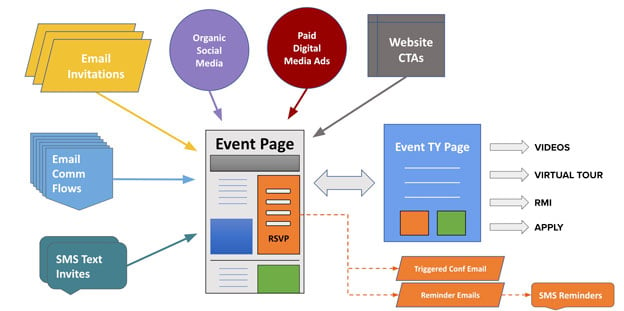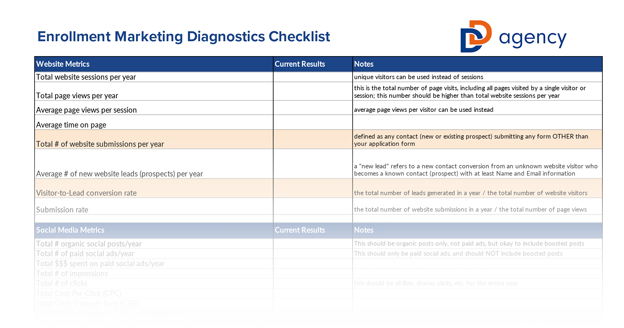How to Build a Strategic Enrollment Marketing Plan

January 12, 2024

The hardest part about building a strategic enrollment marketing plan for student recruitment is figuring out where to start. Most schools are already operating a handful of enrollment management tactics, CRM systems, email communications flows, info sessions, and marketing campaigns.
There is a lot of pressure on enrollment management professionals to react to problem areas, and this narrowed-in focus often prevents schools from being able to zoom out and assess the entire enrollment marketing plan from start to finish.
Although it is often more gratifying to identify underperforming tactics and implement solutions to improve them, it is extremely important to start with strategy before getting into tactics (hence the term “strategic enrollment marketing plan”). In order to start with strategy, it’s important to have an understanding of the core components of a comprehensive enrollment marketing plan that we have found are the most commonly recurring elements that the best strategic marketing plans all have.
The 7 components of a strategic enrollment marketing plan
- Clearly Defined Goals
- Prioritized Strategic Focus Areas
- Organized Marketing Campaigns
- Identification of Target Audiences
- Identification of Tactics and Conversion Opportunities
- Budget Allocations
- A Method for Measurement
Most schools already have a few of these components in place and need to complete their plan by addressing the parts they don’t. Others may have awareness of all of the components, but they are not spelled out in any usable action plan or document that the enrollment management and/or marketing teams can easily refer to and measure against. There are dozens of formats available, but what ultimately matters is that the marketing plan is clear, measurable, and time-bound (i.e. the timing of various marketing activities is intentionally planned out over the recruitment cycle).
All too often, enrollment management teams make the mistake of agreeing to do a bunch of marketing tactics but don’t actually have a clear plan for when, how much, and what the goals are for performance outcomes. For example, a school might agree to add digital advertising and SMS texting into their marketing efforts. Without a clear plan for which campaigns, what audiences, and budget allocations, the assessment of those tactics will be limited to vanity metrics and it will be much harder for the school to truly assess performance and ROI.
The purpose of crafting a strategic enrollment marketing plan is not to just map out a strategy for the future but also to be able to refer back to what was intended so that you can analyze the results against the original approach and make adjustments accordingly.
Regardless of whether your institution has some or all of these core components in place, the next step after understanding each component is to identify what you already have available and ready to use. This means first making a list of your existing assets to identify what content and events you already know you can rely on (this is your “foundation” you have to work with). By simply starting with your existing assets you will also be able to see gaps in your foundation, which will likely lead to you coming up with ideas for new assets, campaigns, or tactics to add into the mix. It’s important to make a separate list of new ideas here because most marketing and enrollment management teams are only able to realistically take on a few new initiatives each year.
| Existing Assets | Ideas for New Initiatives |
|
|
Identify your baseline enrollment marketing metrics
Before establishing clear goals for a strategic enrollment marketing plan, there is a crucial preliminary step that most schools skip entirely or have very limited insight into — identifying the baseline metrics for enrollment marketing conversion. Your baseline metrics are the statistics that come from your most recent pipeline of prospective students who have made it through from the very top of the funnel (first conversion) all the way through each stage in the prospect lifecycle, down to enrollment. Baseline metrics are typically measured over the course of a year, but can also be averaged out by analyzing 2-3 years or more.
There are dozens of enrollment marketing metrics that can be tracked, and it is not the case that all of them are equally critical for success. While it is true that the metrics that matter for each school will vary to some extent based on the circumstances each school is operating within, there are certain baseline data points that are universally important for most schools. Gathering this information is the equivalent of “looking under the hood” of your enrollment marketing vehicle, and a smart enrollment management professional will start with a diagnostic assessment before taking anything apart.
That's exactly what we cover in our Enrollment Marketing Diagnostics Checklist. Use this guide to establish your baseline metrics across multiple different channels and enrollment marketing KPIs, including:
- Website

- Social Media
- Event Marketing
- Paid Ads
- Inquiries
- Applicants
- Enrolled Students
Download the Diagnostics Checklist and start measuring your baseline metrics so you can recognize your opportunities to improve and track your progress over time.
Even if you are not able to gather all of the data points to establish every baseline, the primary purpose of doing this work is to identify the conversion rates at each stage of the prospective student journey. As the saying goes, the numbers do not lie, and your school’s conversion rates reveal the quality of the bridges that move your prospects through each stage of your enrollment process. Some of these bridges are strong and wide. Others are narrow, or broken down in places.
Taking the time to gather the data and establish your school’s enrollment marketing baseline metrics will give you a better picture of your current enrollment marketing strategy so that you more easily see the weak points and make a better strategic plan.
Establishing enrollment marketing goals & developing your strategy
Once you have identified your baseline metrics and have at least a skeleton outline for your strategic enrollment marketing plan, the first component to work on is to establish clear goals. The goals of your enrollment marketing plan should be SMART goals: Specific, Measurable, Achievable, Realistic, and Time-bound. There are many ways to go about establishing SMART goals, and one simple method we recommend is using the OKR methodology for goal-setting. OKRs refers to “Objectives” and “Key Results” and can be used for enrollment marketing in the following way:
|
OBJECTIVES |
KEY RESULTS |
|
|
After establishing the primary goals of your enrollment marketing plan, the next step is to develop the overarching strategy that will guide all of the marketing activities you choose to execute throughout the year. The goal here is to spell out the prioritized strategic focus areas that will be the theme behind your marketing tactics and will consume the vast majority of your team’s time and your marketing dollars. Think of it as a list of 4-6 high-level strategies that state the most important thrusts of your enrollment marketing plan.
By spelling out the major areas of strategic focus you are making it clear to your team and other institutional leaders where you will be spending your time, and more importantly, you’re indirectly defining where you won’t be focusing on (because it isn’t stated clearly in this overarching strategic vision!).
Examples of strategic focus areas for a college or university
- Increase the number of prospects for X program(s)
- Expand recruitment territory into the Washington DMV area
- Increase attendance at information sessions
- Diversify the applicant pool for X program(s)
When crafting your strategic focus areas, it may help to be clear with your marketing and/or enrollment team what the difference is between “strategies” vs. “tactics” when it comes to enrollment marketing. Tactics are primarily focused on “the what” of your marketing plan. Strategies are primarily focused on “the why behind the what” of your marketing plan.
|
EXAMPLES OF STRATEGY |
EXAMPLES OF TACTICS |
|
|
How to select the right enrollment marketing tactics
The most difficult part of making a strategic enrollment marketing plan is arguably the determination of which marketing tactics your plan will employ. Today, there are dozens of channels and tactics available to attract and recruit prospective students, and most schools are not realistically able to invest in all areas of marketing. Add to this challenge the constant rate of change in marketing trends each year, which can quickly overwhelm even the most experienced marketers in the higher education industry!
There are two main keys to selecting the right tactics for your school’s enrollment marketing plan:
- [THE PAST] Filling your biggest gaps — If you’ve done the work of establishing your baseline metrics and identifying your primary goals and overarching strategic focus areas, then it should be fairly clear what the biggest gaps are in your foundation that need to be addressed. What are the channels and tactics that are most likely to fill these gaps in your enrollment marketing program?
- [THE FUTURE] Aligning with new priorities — Most schools have at least one or two new priorities each year that were not part of the previous recruitment cycle’s plan. Are there new priorities for this next year that you need to ensure your enrollment marketing plan supports? What are the channels and tactics that are most likely to help you meet these new priorities?
Of course, there are several other important factors to consider when selecting the tactics for your enrollment marketing plan. Your available budget may limit how many different tactics you can invest in, or your internal teams may not have the time or skills necessary to execute certain initiatives. For example, growing your school’s organic search rankings may be a big priority, but you may not have anyone available who knows how to do search engine optimization (SEO) successfully. The only other option would be to outsource this tactic to a professional services agency that can do this for you, but that will obviously impact your budget.
The important thing to remember in this part of the planning process is to be realistic with the total number of different tactics you add to your strategic game plan. Generally, the more channels and tactics you include, the larger the budget you will need and the more people at your institution who will need to be involved. It is often the case that the most successful enrollment marketing plans are less spread thin because they limit their plan to a select set of initiatives that they can really focus on.
Here are the most common enrollment marketing tactics that are used for student recruitment:
- Email marketing (comm flows + one-off emails)
- Social media marketing (organic and paid social advertising)
- Digital advertising (paid search and display ads)
- Content marketing (blogging, thought leadership, long-format content, podcasts)
- SMS Text Messaging
- Website/Landing page marketing (calls-to-action, chatbots, pop-ups, etc.)
- Video Marketing
- Direct mail
- Space advertising (billboards, large format ads, industry publications, etc.)
- Apps/TV/Radio advertising (Hulu, Pandora, etc.)
- Event marketing (college fairs, information sessions, open houses, guest panels)
Regardless of which channels you end up selecting for your enrollment marketing plan, it is vitally important to make sure you are investing your time and budget in some combination of short-term and long-term marketing tactics. When it comes to enrollment marketing and recruitment, it’s important to understand the difference between “short-term” and “long-term” activities in a typical prospective student’s lifecycle:
Short-term Tactics = marketing efforts that can be implemented quickly and generate quick results that lead to prospect engagements within 1-4 months, and that typically fall off as soon as effort/investment is reduced.
Long-term Tactics = marketing efforts that take more time to get off the ground, generate a bigger impact that leads to prospect engagements in 4-12 months, and typically keep producing results well after the initial investment of time and money.
|
SHORT-TERM MARKETING TACTICS |
LONG-TERM MARKETING TACTICS |
|
|
Today’s marketing mix of both short- and long-term tactics requires enrollment and marketing teams to be nimble. Understand that some tactics may not provide clear and measurable results (e.g. radio advertising), but serve an important role in the overall branding of the university. Having clear strategic priorities will help prevent you from falling into the trap of trying to do everything at once only to see meager results.
Budget obviously can be a barrier for many institutions, but keep in mind that some tactics you may already be doing—such as email nurturing or developing content—may only need small tweaks to improve performance. Don’t get caught up in doing the “next big thing” unless the enrollment and marketing teams (and, in some cases, the administration) understand the overall strategic focus areas.
Creating effective enrollment marketing campaigns
After deciding which tactics your school’s strategic enrollment marketing plan will employ, the next step is to organize your efforts into intentional marketing campaigns. For enrollment marketing, a marketing campaign is a dedicated effort to promote some sort of “offer” over a fixed period of time.
Marketing campaigns can run as short as a few weeks to as long as an entire year, but for most schools it’s best to limit your marketing campaigns to 1-3 months. There are many reasons for this, but the main benefit of limiting your campaigns to no more than three months is that it enables a greater ability to learn from data and improve your next campaigns. Schools that run long-term campaigns tend to not look at results until after the campaign ends, and by then it is often too late to impact a typical recruitment cycle. Make sure you decide what you want your outcome to be in order to help drive the campaign.
Another reason it is important to plan out your marketing campaigns is that it will help you strategize when you want to promote the content, events, and admissions information you have available to prospective students. A marketing campaign typically has a primary offer and multiple secondary offers. The primary offer can be a piece of content, such as a video or a resource guide. Secondary offers provide additional resources once prospects engage with your primary offer and could include blog posts, opportunities to schedule a meeting with a staff member, or other guides or resources.
To build a basic marketing campaign, you first start with the primary offer and work backward from that asset to select the tactics and channels by which you will drive prospects to that offer. These are called “campaign drivers” and their purpose is to create pathways for prospects to engage with the primary offer. Here’s an example of a marketing campaign that has an event as the primary offer:
Example of an Event Marketing Campaign

There are many types of marketing campaigns and dozens of marketing tactics that can be used in each campaign. It’s important not to get overly complicated and attempt to use too many channels and tactics. More often the best-performing marketing campaigns use fewer tactics more thoroughly instead of more tactics less effectively.
For the purpose of crafting a strategic enrollment marketing plan, the reason to organize your efforts into marketing campaigns is to be able to plan the timing of your marketing promotions more intentionally throughout the recruitment year, and to be able to view your major initiatives at a higher level so you can think strategically. You want to be able to look at your campaigns and plan them out by thinking through these kinds of questions:
- When is the right time to promote that new animated explainer video for the new program?
- Is there enough time to advertise the Fall Open House on that date, or should we push it back to allow more time to generate more RSVPs?
- How long can we afford to run retargeting ads leading up to the new application deadline?
It’s also important to keep in mind that not all campaigns deserve the same amount of effort, budget investment, and time frame. Some of your campaigns will be more important than others, and you want to make sure you are putting more time and budget into the campaigns that are most important, but also leaving enough leftover funds for the smaller initiatives that still need to be promoted.
How to adjust your enrollment marketing plan throughout the year
One of the benefits of crafting a strategic enrollment marketing plan is to be able to use the plan throughout the year and evolve it based on real data from each major marketing campaign as your year unfolds. The best enrollment plans are flexible and have room to be molded over time rather than set in stone. However, this requires an intentional effort to regularly review your progress against the high-level goals. This can be done at pre-determined checkpoints (e.g., every 3 months), or it can be done after each marketing campaign has reached a natural endpoint. Either way, this is where the hard work of gathering your previous year’s data and establishing your baselines will really pay off.
In addition to the common practice of reviewing the current cycle’s numbers for inquiries, applications, and deposits to date (in aggregate and/or by program), there is significant value in reviewing the Objectives and Key Results you outlined in your enrollment marketing plan. By looking at other important marketing metrics — such as total numbers of top-funnel leads, form submissions, content conversions, page views, keyword rankings, booked meetings, etc., — you will be able to make important strategic pivots to improve results before it is too late in your recruitment cycle.
One of the best ways to make changes in your enrollment marketing plan in the middle of the year is to work the numbers backward using your baseline conversion rates. For instance, if a certain program is significantly down in completed applications, you should be able to work the numbers all the way back to the top of the funnel to identify the number of started apps, inquiries, event registrations, leads generated, and total page views you need to close the gap. Then you can make decisions on what tactics need to be adjusted in order to reach those numbers. This could look like doubling down your investments in certain areas (and thereby pulling back in others), or it could look like employing completely new tactics in exchange for other campaigns you had planned to do later on.
The key here is that the enrollment management team (and your institutional leadership) should all be on board with a certain amount of adaptation to the enrollment plan throughout the year.
This is the purpose of having a plan in the first place. A true strategic enrollment marketing plan allows for the ongoing improvements that inevitably need to be made in today’s fast-paced, multichannel environment.
Enrollment marketing mistakes to avoid
As enrollment marketing professionals, many can recite stories of institutional leaders and/or faculty sharing an ad or an email from another university and asking, “Why aren’t we doing this…?” In many cases, this comes from a lack of understanding of what competitors are doing, or even what it takes to play in the digital marketplace.
What tends to happen to many of us is that we try to quickly come up with a game plan, which ultimately leads universities to make hasty mistakes like using multiple vendors and inadvertently overlapping efforts with other units/offices, or a misunderstanding of our audience leading to ineffective promotion and recruitment efforts, to name a few. Some key mistakes to avoid include:
#1. Adding tactics to your marketing plan without a strategy.
This results in:
- Lack of Insights on which efforts are generating the biggest impact (ROI)
- Wasted spending especially when it comes to media buys
- Dis-integration due to disjointed and misaligned recruitment efforts
- Loss of Focus on what metrics actually matter, leading to an overemphasis on “vanity metrics”
#2. Having a strategic plan without baseline data and without clearly measurable goals.
Go back to your school or program's baseline statistics that you’ve collected. Don’t necessarily follow what your competitors might be doing, but let the data help guide those decisions.
#3. Strategies that don’t fit budgets.
Consider what is most important in your overall strategic goals and be realistic on what you can spend. Some schools in highly competitive markets or schools with very strong brand recognition may require a very different budget.
#4. Not getting buy-in from administration and/or program administrators.
Ultimately, your team is responsible for bringing in the numbers. Enrollment management professionals are feeling the squeeze these days due to changing demographics, particularly at the undergraduate level. Taking the time to educate internal audiences will save time later when strategies need to be realigned or completely changed.
Overall, the most important thing to remember is some of this takes time. Rome wasn’t built in a day and neither will your strategic enrollment marketing plan. Allotting time to review your baseline metrics, identify your strategic goals, and develop your plan takes time and they don’t always fall in that order! Avoid some of the pitfalls many of us have done in the past by trying different tactics to see what sticks. Sometimes you get lucky, but in the long term, it may not always work out. It is often the most difficult to be patient, especially when there is a strong urgency to improve performance from institutional leaders!
Remember, study your audience. Understand there are shifts in demographics and the way students search for information. Pay attention to the campaigns you are running and monitor their performance. Things are changing, but just as much as they change, some tried and true tactics sometimes still prevail. Use your data, do your research, and be okay if some things do not work as planned.
Establish Your Baseline Metrics
The first step toward building a strategic enrollment marketing plan is to first establish your baseline metrics. You need to have a clear picture of where you currently stand, which channels are driving results, and where you have the most opportunities to improve.
You can do this using your most recent pipeline of prospective students who have made it through from the very top of the funnel (first conversion) all the way through each stage in the prospect lifecycle, down to enrollment.
Once you have those baseline metrics, you can lay out goals that are clear, measurable, and attainable.
Download the Enrollment Marketing Diagnostics Checklist and start building your baseline today!

Contributing Author
.jpg) EBOOK
EBOOK
See how schools are using HubSpot for their enrollment marketing
Service Categories: Enrollment Marketing, Student Recruitment










.png)